
Recently ABIT has been releasing new designs and concepts one after other. After IT7 and AT MAX-MAX2 series, they are now offering a very extraordinary product, OTES (Outside Thermal Exhaust System). For the last few months there have been rumors on the net about OTES and even we had some pictures. However we knew very little about the product until ABIT sent the samples. Since we have the samples now, we can take a look at OTES and its performance.
With OTES, ABIT has officialized overclocking. In some manner, the company states that they will sell o/c products from now on. This may again cause overclocking arguments. Or even NVIDIA may show opposition to this action. We’ll see what happens sooner, but anyway I don’t think that the users will be against this.
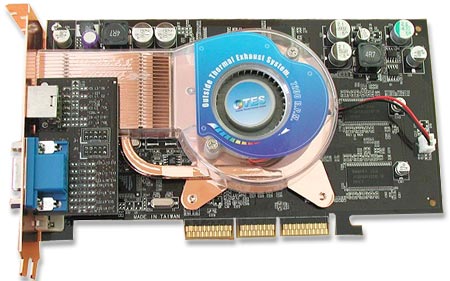
As you see in the picture above ABIT Siluro GeForce 4 Ti4200 OTES is very extraordinary and attractive as much. OTES which features fan-heatsink architecture far different than the others is totally made up of copper. Copper has a better thermal conductivity and thus is better than aluminum as a heatsink material. Also the fan has a rotation speed of 7200 rpm which is beyond the standards. The fan turns in a plastic cylinder. The heat produced is disposed directly from out of the case by means of the air circulation created.
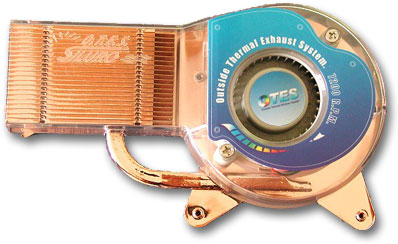
As you see in the picture below the air is pumped off the case through the exhaust hole beside the DVI output. The heat-pipe that you see in the above picture uses the same system that is used in CoolerMaster’s new fan designs. The only goal is to get rid of the heat as quickly as possible. If you consider the total surface of the heatsink, the weight, high fan speed and operation system, I can say that OTES is the most complicated and potential cooling systems I have ever seen. Of course I mean aside from the water cooling and similar systems. Also the direct transfer of heat out of the case is crucial for the stability of general system temperature.
You can see that the width of the back panel is twice than the normal. Thus the PCI slot right next to AGP is occupied and you can not install any other card on it. But if you have an Abit MAX series mobo then it is ok since MAX series mobos are designed in a way that there is an extra space near the AGP slot and therefore the card doesn’t block the PCI. Anyway, it is recommended that you leave the PCI slot next to AGP empty to prevent possible IRQ conflicts.
While the DVI output is on the PCB, the VGA and S-Video outputs are attached on an additional card. Although some may think that this would affect the 2D quality I haven’t seen any visible difference. Moreover, since the bundle contains a DVI-VGA adaptor, you can connect your monitor to the standard DVI output/
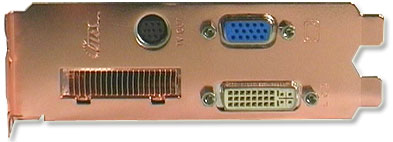
Abet took advantage of this 15% more efficient system by overclocking Siluro GeForce 4 Ti4200 one step up the normal. While a standard Ti4200 operates at 250 MHz. core and 500 MHz. RAM frequencies, ABIT OTES has a 275 MHz. core and 550 MHz. RAM speeds. These values are exactly the same as a standard GeForce 4 Ti4400.
With this special cooling system, it is no challenge to increase the core speed by 10%. In fact the main problem is due to the bottle neck effect of RAM bandwidths, rather than 3D graphic cores. OTES uses its 3.6 ns Hynix brand RAMs at 550 MHz. (275×2). Actually this is the ideal operation frequencies for these tams. (1000/3.6ns=277Hz.)
Thus you don’t have much chance to overclock the RAMs more. ABIT made a good job by increasing the core speed to 275 MHz. however it would be much better if they used 3ns. or 2.8 ns RAMs so that the RAM speeds could reach the level of GeForce Ti4600, 650 MHz. or 700 MHz.
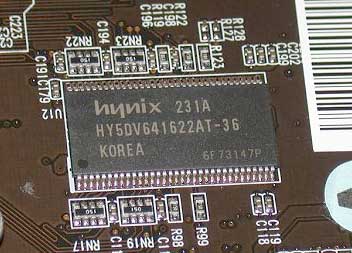
We have already mentioned that OTES is overclocked by 10% to reach 275 MHz. If you depend on this cool cooling system then you can overclock it up to 300MHz. However I had some stability issues at this speed. I think the best frequency with stability is 285 MHz. I have used it at 285 for two days without having any trouble.
For RAMs, we have already said that they are working at their normal, 550 MHz. Although they can be overclocked to 600 MHz. again they become unstable. Even if the system remains stable, the graphic quality drastically decreases in many 3D applications like 3D Mark 2001SE. The best value I get with stability is 585 MHz. These both values are in fact very satisfactory. You can have a card working at 285/585 MHz., which is just a few steps slower than GeForce 4 Ti4600. But I have to tell you that you must always consider the risks when overclocking.

OTES’s box contains a small brochure introducing OTES, user’s manual, cables for S-Video and Composite Video, a “Y” cable to change S-Video output to Composite, WINDVD based SiluroDVD 4 Soft DVD software and DVI-VGA adaptor.
TEST SETUP
CPUPentium 4B 2.4GHz
Memory2 x 256MB PC3200 CAS2 Corsair DDR-SDRAM
MotherboardsAsus P4GE-V
Video CardAsus V8640, 300/325MHz
ABIT Siluro GF4 Ti4200 OTES 275/275MHz
Hard DriveMaxtor 5T030H3
MiscellaneousToshiba 32x CDROM, ElanVital 300W PSU
3Com 3C905B-TX ethernet
SoftwareWindows XP SP1
NVIDIA DetonatorXP v40.41
Direct X 8.1
Now let’s take a look at the performance of OTES. We will use GeForce 4 Ti 4600 and Ti4200 for comparison. You can check the rest of the system components from the table above.We will first use 3D Mark 2001SE build 330. As you see, in the standard settings, OTES is gets 5% more score than a conventional GF4 Ti 4200. This rate increases to 10% when FSAA is activated. At the same time, it is 7% slower than GeForce 4 series’ top model. It is 13% slower than Ti4600 when FSAA is on.
The results are as follows in Unreal Tournament 2003 at 1024x768x32bit resolution. In BotMatch all of the three cards perform approximately the same. If you want more performance in BotMatch you must consider faster CPU and system RAMs. In Flyby mode OTES is 10% faster than a standard Ti4200 and 8% slower than Ti4600. As you see, it doesn’t matter whether a Ti4200 or Ti4600 if you want to play Unreal Tournament 2003.
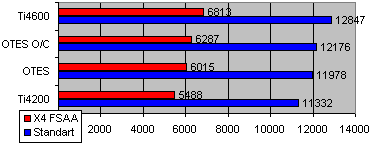
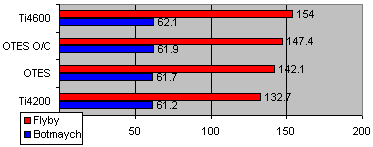
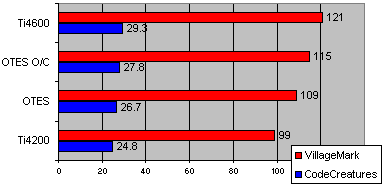
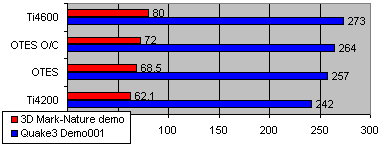
The results are as expected when you run Quake 3 v1.17 at high quality settings in 1024x768x32bit resolution. The gap increases a little but not much in “Nature” test of 3D Mark 2001SE.
For DirectX 8.1 test we used CodeCreatures Benchmark Pro. All cards perform about the same. In fact in these kinds of benchmarks were there are a lot of surfaces the score mainly depends on the CPU speed and thus you can’t get much different results. The difference is 2 frames with Ti4200 and only 5 frames between Ti4600. In VillageMark v1.19, where the score depends on Ram performance and fillrate, the card with the fastest ram speed gets the best score. Consequently OTES is 10% faster than Ti4200.
Siluro GeForce 4 Ti4200 OTES’ performance is not different from a standard Ti4400. You may only complain about the noise of the 7200 RPM fan. Anyway, if you are using an Athlon, you are probably used to fan noise. I think OTES’ cooling system should have included the RAMs and RAMs should have been faster ones. If 3ns or 2.8 ns. Rams were used, I am sure OTES would be more attractive.I don’t know if Abet will apply OTES to other graphic cards but the next design should have some retouches. The official release of an overclocked product may cause some disputes in the future.As a result if you think about the price which is close to a standard GF4 Ti4200, who would not decline to get a Ti4400 by paying the price of a GF Ti4400 ?

